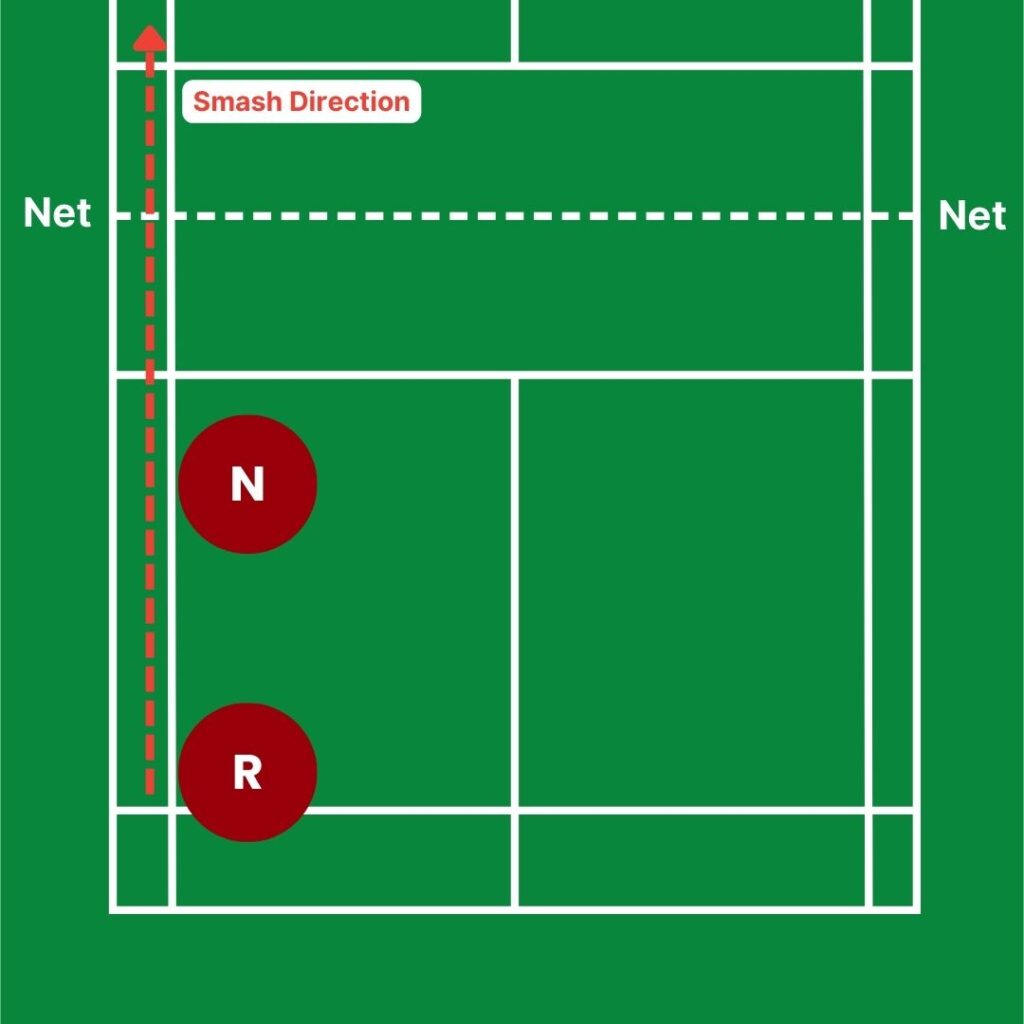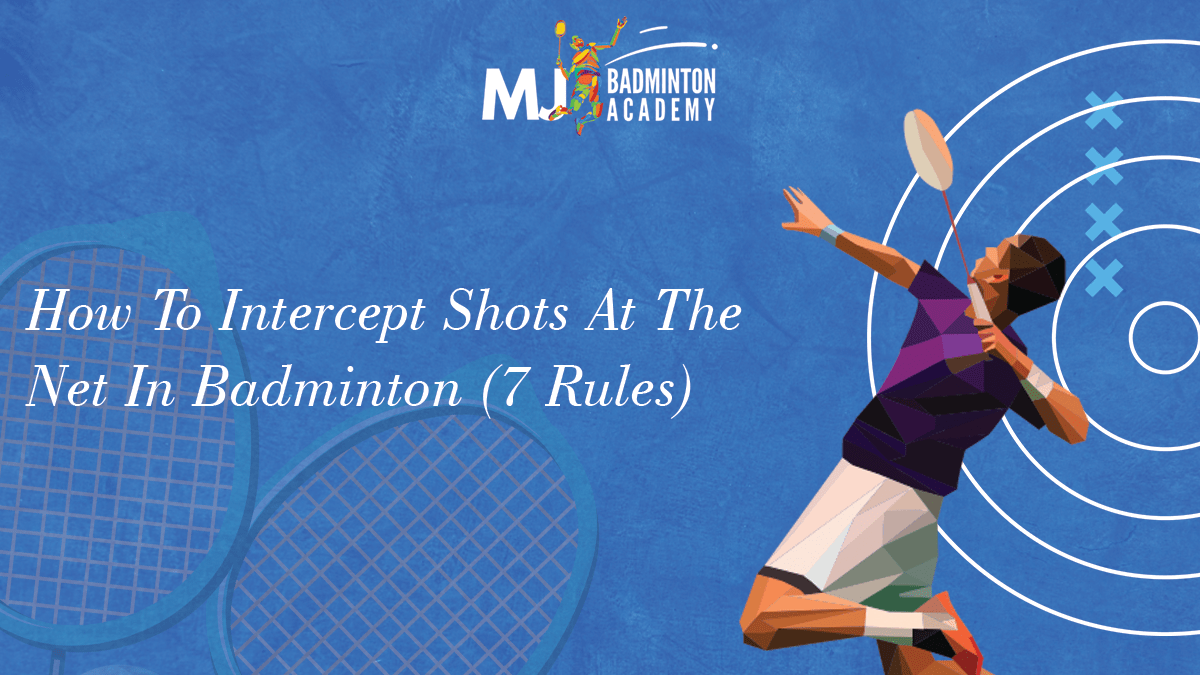How To Intercept Shots At The Net In Badminton: A net interception in badminton is when the opponent hits a hard shot and the net player is able to hit that shot before it goes past them.
Intercepting these shots will not only help your partner out, but it will give your opponents less time to react and put them under more pressure, helping you to win more points as a result!
But sometimes it can be hard to know when you should intercept a shot or leave it for your partner. Or to know how to play a good shot when you’re intercepting.
But if you can learn this you will be a much better badminton player!
Table of Contents
How To Intercept Shots At The Net In Badminton
- Stand in the correct position
- Be aware of where your partner hits to
- Watch what your opponent’s are doing
- Have the correct racket positioning
- Improve your reactions
- Practice
- Take risks
We’ll now go through each of these rules in more detail, so you can gain the knowledge and confidence to take your net interceptions to a whole new level!
Rule 1 – Stand In The Correct Position
How Far Back Should You Stand?
A very common mistake we see is that people often stand too close to the net! Being too close to the net makes it more difficult to react in time, leading to you either mistiming the shuttle or missing it completely.
We’d recommend standing around here to be able to intercept almost every shot:

What Side Should You Stand On?
Now you know roughly how far back to stand, which side should you stand on? Let’s go through two scenarios to help you understand this better.
Scenario 1
When your opponents have lifted and you know your partner is in a good, threatening position at the back, you should stand slightly further over to the side that your partner is on (we’ll go through why you should to do this in the next rule).

Scenario 2
When your opponents have lifted but this time your partner is off balance and in trouble at the back, you would now stand slightly to the other side. This is because your partner is likely to play a worse shot and your opponents will want to hit into the big gap on the other side of the court. Standing slightly to the other side means you’re more likely to be able to intercept this shot!

Bearing those 2 scenarios in mind, you should almost never be stood in the middle of the court, and this is a very common mistake people make!
If you only ever stand in the middle, it makes it difficult to intercept any shots to the sides – unless your opponents hit it straight to you. It also makes it difficult for your partner to know which side to cover, resulting in them having to cover BOTH sides!
Another bonus tip is to have your feet at a slight diagonal in line with the corner that you think the shuttle is going to go, as this will help you be much faster and therefore more likely to intercept the shuttle!

Rule 2 – Be Aware Of Where Your Partner Hits To: How To Intercept Shots At The Net In Badminton
Being aware of where your partner hits to is important so that you can calculate the likely reply, and adjust your positioning accordingly! Here are 3 tips for mastering this:
1) If your partner is playing lots of soft drop shots and your opponents are taking it late then it’s almost impossible for them to play a flat lift, and the most likely shot is either a net shot or a high lift. In this scenario, you should be much closer to the net!
2) Add in some ‘set plays’ to create an interception opportunity. As mentioned earlier, if your partner is in a good position and you move slightly to the same side, your partner could hit a straight smash down the tramline because the most likely reply is a straight shot, which you can then intercept!
This is called a ‘channel attack’.

There’s 1 common mistake that prevents you from doing these set plays – a lack of communication with your partner. You can’t get angry at your partner for smashing down the middle and not setting up your amazing interception, because you haven’t told them to smash straight!
3) Listen to the sound of your partners strings as they’re hitting as this is the best way to figure out what shot they’re playing! To keep it simple, a louder sound is typically a smash, which means the shuttle is more likely to come back harder so you can intercept it, and a softer sound would typically be a drop shot where you then might move your position forward slightly.
A lot of people tend to turn around to see what shot their partner is hitting, but we wouldn’t recommend this as it’s dangerous and you can’t keep an eye on what your opponents are doing, which leads us onto the 3rd rule…
Rule 3 – Watch What Your Opponents Are Doing: How To Intercept Shots At The Net In Badminton
Watching what your opponents are doing will help you decide how far back to stand, and also where to stand.
Let’s go through 3 examples:
1) If you see your opponent coming in with a straight arm and one slow motion, they’re more likely to block the shuttle so you’d want to be stood closer to the net.
2) If they look like they’re preparing with a big back swing, this means they’re more likely to hit the shuttle hard and you can then be ready to intercept it.
3) Or, if you hear your partner smash and your opponent on the straight turns to face cross court you know the smash is going cross court, so you can start to move over!
Seeing these cues from your opponent’s body and racket positioning will really improve your ability to intercept shots.
Rule 4 – Correct Racket Positioning: How To Intercept Shots At The Net In Badminton
We’d recommend being in a relaxed forehand grip for almost all interceptions, no matter which side the shuttle is on.

This is because you should try not to change to a backhand grip to intercept a shot as it takes too long! This means you wouldn’t be taking the shuttle as early, and therefore wouldn’t be able to play an aggressive shot.
So, where exactly should you have your racket?
Well, this is up for debate and we’ve discussed this in a lot more detail here but in general, we’d recommend:
- Having your elbow up as your opponent is about to hit it. This means you’ll be faster to the shuttle, and it will help you play a better shot.
You will see a lot of players (especially pro players!) with their rackets seemingly by their ankles but this is because they have lightning fast reactions and racket speed so they’re able to bring their arm up as their opponent hits it!
If you can also be successful doing this then go for it, but for most players (us included), it’s usually better having your racket ready earlier, which is JUST as your opponent is about to hit their shot.
Remembering rule 2 and 3, you should change the height of your racket positioning too:
- Higher if your partner hits a steeper shot as the shuttle is more likely to come back higher.
- Or, a bit lower if your partner hits a flatter smash or drive.
Rule 5 – Improve Your Reactions:How To Intercept Shots At The Net In Badminton
The previous 4 rules have largely been about your predictive mechanisms and anticipation to help you intercept better, but improving your pure reaction speed will also help.
Rule 6 – Practice!: How To Intercept Shots At The Net In Badminton
You wouldn’t expect to pass your driving test without ever having driven a car… so how can you expect to intercept well without practicing beforehand?
Here are 2 ways you can practice:
1) Practice 1 is where someone hits in 1 shuttle at a time, hard but in an upwards direction and you have to intercept it and hit a hard shot back in a downwards direction. We’d recommend starting with one side only, then moving to the other side!

2) Once you’ve mastered the technique, you can now practice the “random” element of interceptions. For this you need 3 people where a feeder lifts, your partner is behind you and smashes at the feeder, and the feeder then hits a drive for you to intercept.
This is where you can practice improving your predictive mechanisms – by looking for the straight interception if your partner smashes straight, or maybe the cross-court interception if your partner smashes down the middle.
Rule 7 – Take Risks
You need to take risks – both in training and in matches!
You won’t always make the right decision but you’ll learn over time what are the right and wrong shots to go for. However, there is often no one right or wrong way to move, or shot to go for in badminton and even the pros don’t get it right 100% of the time.



